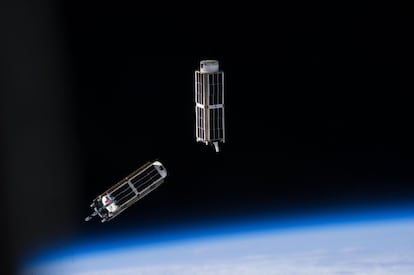Space exploration: Artemis I’s forgotten passengers
As soon as the last stage of the rocket was shut down, 10 small satellites were ejected. Some of them have failed to reach their destinations, but most are still active

Despite being unmanned, NASA’s Orion capsule is monopolizing the attention of those who follow space exploration, especially through its spectacular views of the Moon. As soon as the last stage of the rocket was shut down, with the capsule already en route to the Moon, 10 small satellites acting as passengers on the trip were ejected.
Almost all of these satellites are based on a common design: the Cubesat. These are vehicles composed of cubic modules with sides measuring only 10 centimeters in length. These CubeSats have been sent to various destinations including the Moon and asteroids. The idea is for them to study various facets of the Moon and interplanetary travel, ranging from navigation techniques to radiation and biology. One of them is even set to conduct a landing on the lunar surface.
Some of these satellites have been promoted by special agencies such as the Japan Aerospace Exploration Agency (JAXA) or by NASA itself; others represent the interests of private citizens, such as the so-called Team Miles, a shoebox-sized device equipped with a set of four newly designed ion engines. They emit iodine ions and provide barely half a gram of propulsion – enough to slowly alter position or trajectory.
LunIR and Lunar Ice Cube will operate from lunar orbit, searching for the signature characteristics of certain base emissions, in particular water. Of course, their journey will be a long one. Lunar Ice Cube, for example, follows a trajectory that will require three months to reach the Moon. This is because it has to do so at a very low speed so that the small on-board engine, which is also electrically propelled, can slow it down and force it into orbit.
The presence of water on the lunar surface is the holy grail of many of these explorations. The LunaH-Map satellite will attempt to detect hidden ice to a depth of one meter. Its orbit will cause it to pass successively over the Moon’s poles, in particular the Shackelton crater, one of the most promising areas in terms of water presence, located at the south pole.
To locate water a neutron detector is deployed – basically a crystal of lithium, cesium and yttrium that flashes briefly upon impact. This method has already been used in other probes, specifically in the search for water on Mars, but in the case of LunaH-Map, taking advantage of the fact that it will fly at a very low trajectory, it will allow for the composition of ice distribution maps with a much higher resolution.
JAXA has contributed two satellites to this mission. EQUULEUS will analyze the plasmasphere around the Earth, an important factor in the protection of future astronauts. It will also make several lunar fly-bys and analyze the flashes produced when a meteorite hits the Moon.
Like the other satellites, EQUULEUS also carries its own propulsion system: a water-powered engine that heats its liter and a half of water to boiling point, with the resulting steam expelled through the nozzles. It doesn’t provide much thrust – more or less the same as an ionic motor.
The other Japanese satellite, OMOTENASHI, is the only one of the 10 satellites that was designed to land on the Moon, albeit using a somewhat precarious method. The plan was for the 700-gram capsule to slow its descent by firing a small motor at an altitude of only 100 meters. From there, it would continue in free fall, cushioning the impact with an airbag. OMOTENASHI carried just two instruments: a radiation detector and an accelerometer to measure the impact of the landing.
This is not the first time this method has been used. Back in the 1960s, NASA sent three Ranger probes to plant a seismometer on the Moon. The instrument was to be wrapped in a balsa wood sphere, a material that was to deform on impact, thus absorbing much of the energy of the shock. None of the three probes completed their mission.
OMOTENASHI has also been unsuccessful. After a series of communications problems, JAXA announced via Twitter at the end of last month that it was writing off its mini explorer.
The NEA Scout, a small satellite equipped with a deployable solar sail, may have more luck. Like a racing yacht, it was designed to sail through space powered only by the slight pressure of the solar wind. Its target: a tiny asteroid discovered a couple of years ago that doesn’t even have a name, just the code 2020 GE. The asteroid is 18 meters in diameter and would be the smallest Solar System object ever explored by a spacecraft to date.
2020 GE’s orbit brings it close to Earth: in September 2023, it will be only six million kilometers (3.7 million miles) away. Around that time, the solar sailboat is scheduled to approach it in a slow-motion fly-by at barely 100 km/h, which would allow its cameras to see details on its surface. However, it is unclear whether the operation will be successful as, so far, the tracking stations have not been able to establish contact with the satellite.
Sign up for our weekly newsletter to get more English-language news coverage from EL PAÍS USA Edition

